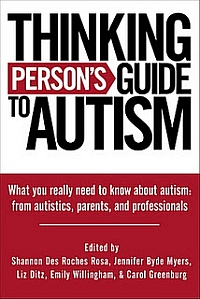 Sometimes I ask for feedback on pieces I’ve written before I post them, and sometimes I’m lucky enough to get a reply that’s in itself more compelling than what I’d intended to post in the first place. So it went yesterday. What I’d had prepared for today may see the light of day once it’s been reworked; for now though I’m preoccupied with something that seems obvious in hindsight, but hasn’t been very well integrated into the common understanding of what we call “the autistic spectrum.”
Sometimes I ask for feedback on pieces I’ve written before I post them, and sometimes I’m lucky enough to get a reply that’s in itself more compelling than what I’d intended to post in the first place. So it went yesterday. What I’d had prepared for today may see the light of day once it’s been reworked; for now though I’m preoccupied with something that seems obvious in hindsight, but hasn’t been very well integrated into the common understanding of what we call “the autistic spectrum.”
In short, however broadly or narrowly one might define that spectrum, the fact is that people are moving across it, around it, onto it, and off of it continually. Whether or not one “is” autistic at any given moment is dependent on environment, situation, context; that is how the spectrum is experienced by those who occupy it—yet we’ve collectively agreed to speak about autism in language that is contrary to that experience.
This collective agreement, in the newspeak of George Orwell’s 1984, is something that is “doubleplusungood” for autistic people.
One theme of that novel was that if the language people use in order to describe and reflect on their world can be reduced and impoverished down to the minimum vocabulary necessary for carrying on labor and consumerism—down to a vocabulary that is not adequate to fully describe or communicate their situation—then they will be infinitely more helpless, docile, and easily manipulated than if they’re able to use a vocabulary that is equal to their situation. For a generation which has grown up with no knowledge that adjectives such as horrific, appalling, or unconscionable even exist, the worst any situation can be is doubleplusungood. It’s kind of funny, yes, and once you grasp the truth of it also kind of chilling.
Much as you might be able to turn on the television “news” and point to any number examples of this dynamic at work, I’m not so sure that the autism world—as viewed from the perspective of autistics—doesn’t provide a far more advanced and complete example. At the very least, we are using a two-dimensional model, “spectrum,” to describe a four-dimensional experience that spans time and location. And how many people haven’t felt the fear, if only vicariously, of being reduced by a diagnosis to a mere point, a one-dimensional specimen impaled on a pin in some clinic’s collection.
One direction to go from here is away from behavior-based diagnosis and toward a strict reliance on quantifiable measurements such as brain scans. If and when such scans become available though, does that mean scanning equipment will be “available” in the midst of the bustling, noisy, highly social work environment that brings an employee’s autism into full bloom … or only in the quiet comfort of a clinic where they are able to behave “normally.” I’m told of mothers who deliberately stress out their kid right before an evaluation, to make sure of getting the diagnosis and the school services that follow. Given the situation as it stands, this seems regrettable but justifiable; here too though what’s lacking is a language and a common understanding that takes into account the role that environment, situation, and context play in autism.
A better model than spectrum for autism then would not conceive of it as a discrete phenomenon, separable from when and where it takes place. Maybe you’ve heard about native tribes who have one word for caribou and wolves together, recognizing them as a single, interdependent entity. Minus the suggestion of predator and prey, something like this is needed for autism. The word ought to connote an interdependence of situation and person, a dynamic to be managed rather than a pathology (or a predator) to be excised and banished. Autism is not to be plotted on a spectrum; it’s something that happens in the midst of an energized field, surrounded by movement. All appearances aside, it’s never happening in isolation, and is no more of a condition than it is a dance.
When we have clinical language which reflects that reality of interdependence, we’ll be on our way toward having a vocabulary that is adequate to describe the experience of being autistic. And maybe then I’ll be able to write the piece I’d intended for today.
Mark Stairwalt on 03/5/10 in featured, Politics | 2 Comments | Read More
Comments (2)


What about my landscape model then.
The landscape is a 3 dimensional terrain with peaks and valleys, rivers etc.. which one can inhabit or move around in the fourth dimension.
It’s natural boundaries are geographical but the labling is political, in that the landscape is arbitrarily divided into countries that bear no great relationship with the actual physical terrain.
For example I could be an autistic flatlander who lives close to dyslexic flatlanders but on the other side of the river that divides the country into two.
Going down river I might find that the border swerves to carve out another community of tourettic flatlanders who live on both sides of the river.
I could move into the mountains as I grow older, or move back to the desert, or the forests or whatever.
So much to think about and consider here, from both Mark and LR.
I’ve been saying for quite awhile as long as autism is diagnosed on behaviors alone, and the clinicians are subjectively judging it, with bias playing a role, that we’re a far cry from where we should be. Reliable and accurate brain models are where it should head, if we have to have a diagnosis. We either recast this as personality differences (which do appear to be a function of neurology) and so remove it from a medical and psychiatric model, or we move it entirely to a medical (neurological) model.
However, I don’t think that for most people on the spectrum it belongs as a medical model. And for those it would, it is a combination of factors, of neurology, creating the severe disability and not autism alone. Never mind you’ll never convince diehards of this, those who would take all the symptoms their severely disabled child has and call it autism or those who would conceive of their children as vaccine-damaged.